Description: This perennial wildflower is 2-6' tall and usually unbranched, except toward the apex where the flowerheads occur. The glabrous central stem is light green to purple. The alternate leaves are up to 8" long and 6" across (excluding the petioles), becoming gradually smaller as they ascend the central stem. They are quite variable in shape; the lower leaves are often divided palmately into 3 lobes (or less often 5 lobes), while the upper leaves often lack lobes (ovate or deltoid). The margins of the leaves are undulate, dentate, or entire (smooth). The upper surface of each leaf is medium to dark green and hairless, becoming yellowish green with age. The petioles are as long as the leaf blades or somewhat shorter. The foliage of this plant contains a white latex.

The central stem terminates in a panicle of flowerheads that is about as wide as it is tall; smaller panicles often develop from the axils of the upper leaves. The typical panicle will have 2-4 widely spreading branches at the apex of a central stalk (peduncle); from each of these branches, several flowerheads and their buds hang downward from shorter branches (pedicels). These branches are hairless or slightly pubescent and light green to pale purple. Each flowerhead is up to ¾" long and ½" across when it is fully open; it has 5-6 outer ray florets and no disk florets. The ray florets are greenish white, cream-colored, or greenish yellow. The cylindrical base of each flowerhead has about 5 primary bracts (phyllaries) that are light green and hairless; each of these bracts is linear in shape and about ½" in length. At the very bottom of each flowerhead, there are also several secondary bracts that are much shorter than the primary bracts. The blooming period occurs from late summer into the fall and lasts about a month. Each ray floret is replaced by an achene with a small tuft of hair; these hairs are either light tan (var. altissima) or orange-brown (var. cinnamomea). The achenes are distributed by the wind. The root system is tuberous. Sometimes this species forms small colonies of plants.

Cultivation:
Preferred growing conditions consist of light shade to dappled sunlight
and fertile loamy soil that is moist to slightly dry. Rocky or sandy
soil is also tolerated. The size of individual plants can be highly
variable depending on soil fertility, moisture conditions, and light
levels.
Range & Habitat:
The native Tall White Lettuce is occasional in southern and extreme
eastern
Illinois, otherwise it is rare or absent (see Distribution
Map). This species is more common further to the east.
Habitats include rich mesic woodlands, rocky upland woodlands, sandy
woodlands, bluffs and shaded ravines, woodland borders, swamps and
seeps, and shaded to partially shaded riverbanks. This species is found
in deciduous woodlands where Sugar Maple, American Basswood, and/or
American Beech are often present as canopy trees.
Faunal Associations:
Information about floral-faunal relationships for this species is
limited. Bumblebees suck nectar from the flowerheads and
cross-pollinate them; Halictid bees, beetles, and other insects may
feed on the pollen, but they are not effective pollinators. Even though
it has a bitter taste, White-Tailed Deer occasionally browse on the
foliage.

Photographic
Location:
A deciduous woodland at Turkey Run State Park in west-central Indiana.
Comments:
Two major groups of woodland lettuce can be found in Illinois and
neighboring states: species of Wild Lettuce (Lactuca spp.)
and species of White Lettuce (Prenanthes spp.).
Species in the former group have flowerheads that are erect or hang
sideways, while species in the latter group have flowerheads that droop
downward. Tall White Lettuce can be easily distinguished from other
species of White Lettuce in Illinois by examining the primary bracts
(or phyllaries) of the flowerheads: each flowerhead has 5 primary
bracts (phyllaries) that are light green and hairless (less often there
are 4 or 6 bracts). Other species of White Lettuce in Illinois have 8
or more primary bracts; depending on the species, these bracts may be
hairy or pale purple. As a general rule, leaf shape is unreliable as a
guide to identification because it is highly variable within each
species of White Lettuce. Other common names that are sometimes applied
to Prenanthes altissima and similar species include
Lion's Foot and Rattlesnake Root.